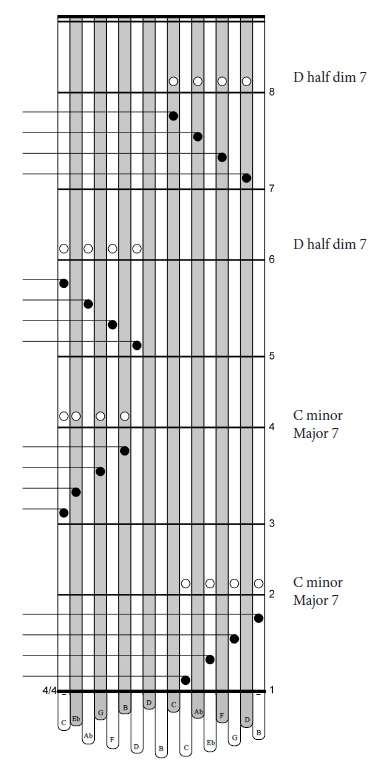Have you ever heard of a “minor major 7” chord? How about a “half diminished 7” chord? Yeah, at the time I had been playing kalimba as long as you probably have, I didn’t either.
On the Freygish karimba, you can make the “C minor major 7” chord by simply playing the four tines on the left side of the upper row. You can play the “D half diminished 7” chord by playing the four tines on the right side of the upper row. In other words, you get them for free, and they are easy and obvious.
And THAT is the whole magic of the kalimba: each kalimba can be, and should be, set up to play its own magic in a very simple way.
First, let me be straight with you. The Freygish Karimba is structurally similar to the African-tuned Karimba, and so I call it a karimba. However, the Freygish tuning is a total reworking of the instrument, and it no longer plays African music. It is a New Age instrument now, rather than an African instrument. But it plays beautiful music just the same, and it points to the infinite sea of musical possibilities that remain untapped in the kalimba family.
Every kalimba player should know what a triad is. Diatonic kalimbas (kalimbas that are tuned to play the “Do Re Mi Fa So La Ti Do” scale in some key) are usually set up to play the major scale by starting in the center and alternating sides as you incrementally move farther out on the instrument. In that setup, “1” belongs to the right thumb, “2” belongs to the left thumb, “3” belongs to the right, “4” to the left, and “5” to the right. Or, you can easily play the “1” “3” and “5” notes because they reside on adjacent tines. It is even simple to strum the three adjacent tines in a glissando move.
That “1 + 3 + 5” chord is called a triad. If you did it the way I intended, it is a major triad. If you strum the lowest three tines on the other side, “2 + 4 + 6” is a minor triad.
All that was from Kalimba 101. Now, welcome to something more advanced.
 You can make slightly more exotic chords by strumming four tines in a row. This will add the 7th to the chord. So, you can make major 7th chords, minor 7th chords, or dominant 7th chords, but you do not have control over which one you make – it depends on what the tines are tuned to and where in the scale you chose to start playing your four adjacent tines.
You can make slightly more exotic chords by strumming four tines in a row. This will add the 7th to the chord. So, you can make major 7th chords, minor 7th chords, or dominant 7th chords, but you do not have control over which one you make – it depends on what the tines are tuned to and where in the scale you chose to start playing your four adjacent tines.
Each different type of triad (three adjacent tines) or 7th chords (four adjacent tines) will sound different. Do listen to how they sound and how they make you feel, Each of these chords will have a different flavor, but in some fundamental way, all of those flavors are variations on “vanilla,” because the diatonic scale is basically vanilla. Good vanilla that you can eat every day, but still vanilla.
The purpose of this article is to say “If your kalimba hasa exotic notes” – ie, notes that are not exactly in the vanilla scale – “you can make exotic chords.”
The exotic note in the Freygish tuning is B natural. B natural is in the key of C major, but in the C natural minor scale, the 7th should be Bb (B flat). If we had that scale, the first chord in the tablature above would be a C minor 7. However, with the B natural, that first chord is a C minor major 7. The 3rd is E flat, which is a minor 3rd. The 7th is a major 7th, which makes this a rich chord – it cannot decide if it wants to be a minor chord (with the minor 3rd) or a major chord (with the major 7th). Mystery!
The next chord, in measure 3, is the same, C minor major 7, but an octave higher. I played the C with my left thumb and played the three upper-row tines with my right thumb.
In measure 5, we have the “D half diminished 7th” chord. For opera fans, Wagner used this chord as a leitmotif for Tristan, and it is sometimes called the “Tristan chord.” However, I am not going to explain the diminished thing – if you don’t understand it, look it up on Wikipedia.
Measure 7 also has the D half diminished 7 chord, up an octave. I do the upper-row glissando with my right thumb, but sliding from center to right, or going down in pitch.
How would you use the half diminished 7th chord? Play it, followed by the G or G7 chord, and then end with a C minor chord (as the last three chords in the recording illustrate).
Enjoy!


Sign up for our newsletter and free resources with your email address:
We pinky promise not to spam you and to only send good stuff.
 Christmas in July 2025
Christmas in July 2025 Patriotic and American Music for Kalimba
Patriotic and American Music for Kalimba